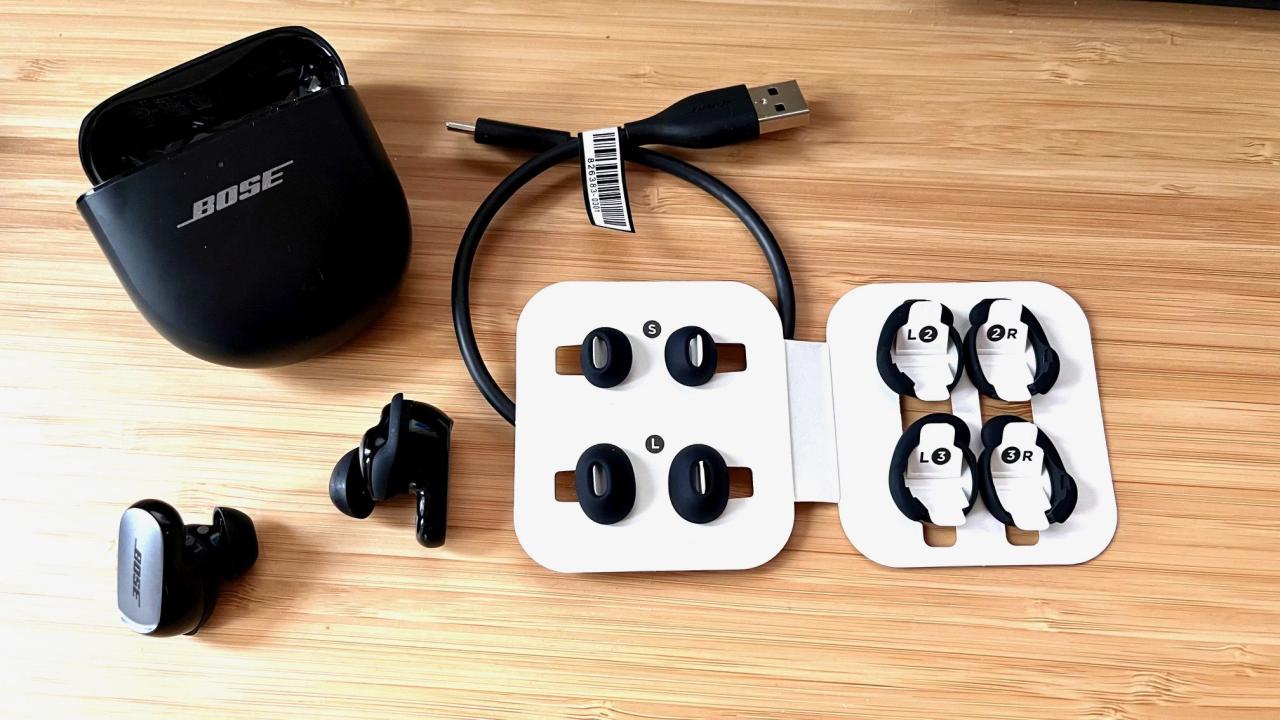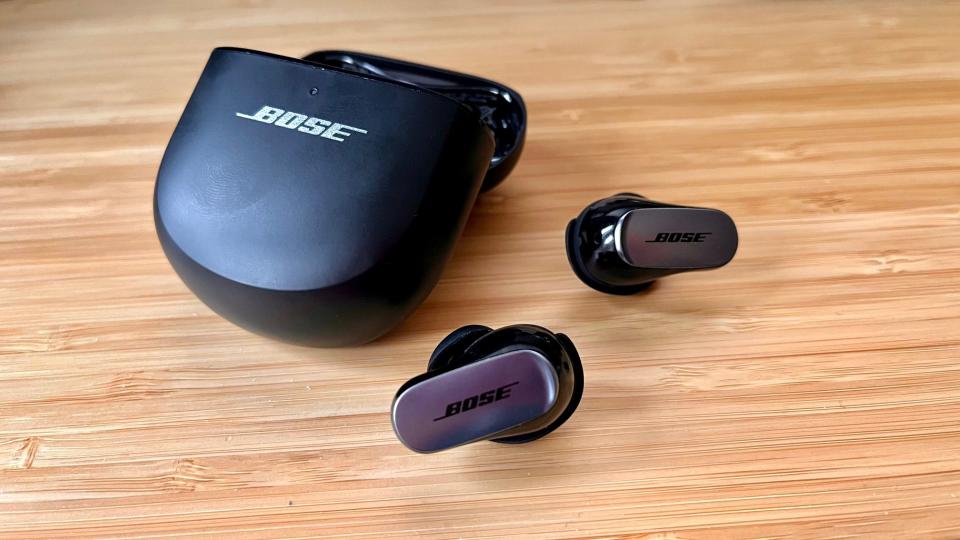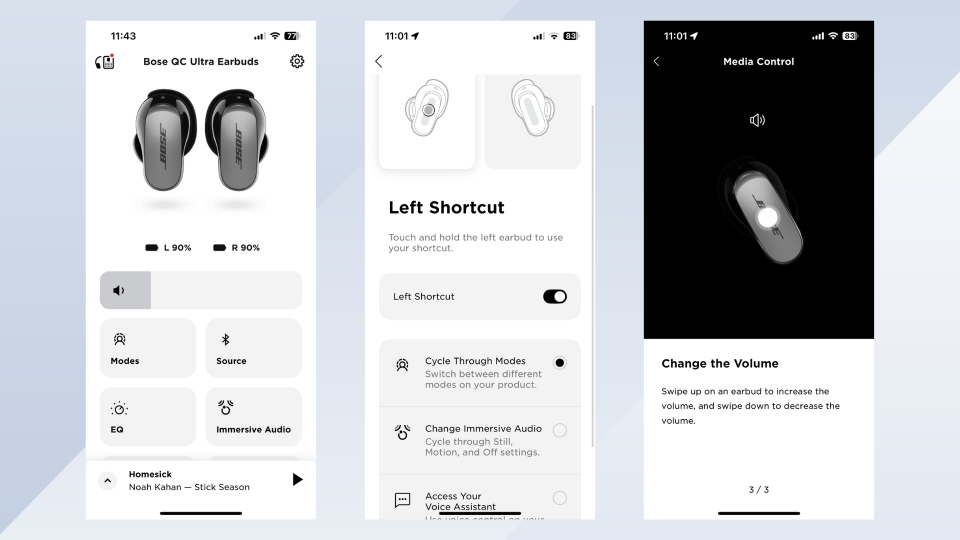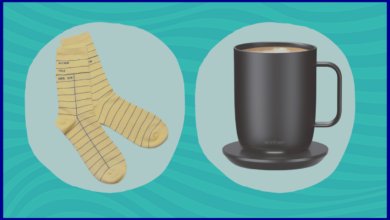Better than AirPods Pro in one big way
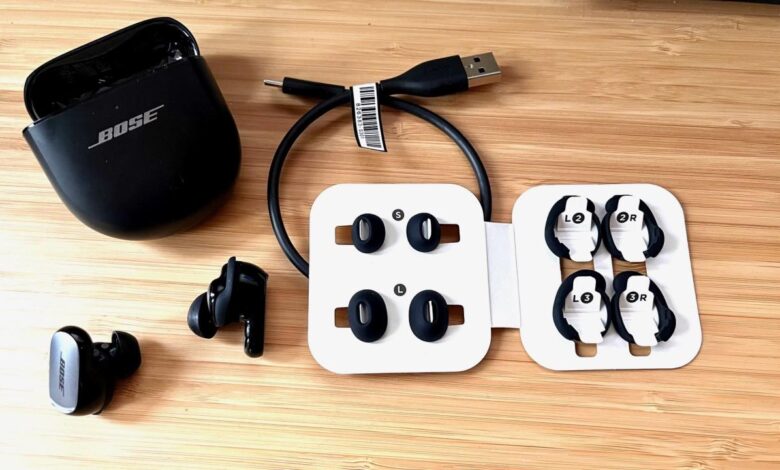
True story: I’m sitting on an airplane, marveling at how quiet it is and how clearly I can hear every string in Vivaldi’s The Four Seasons. The composer gets credit for the opus, Spotify for slinging it to my ears, but it’s the Bose QuietComfort Ultra Earbuds allowing me to listen in peace and enjoy every nuance of the performance. All told, it’s nothing short of miraculous — but is it enough to justify spending $300? That’s the price for Bose’s latest ‘buds, which I’ve been putting through their paces. Here’s my QuietComfort Ultra Earbuds review.
Ear detection: Yes | Spatial audio: Yes | Multipoint connectivity: No | Case charging: USB-C | Max battery life: 6 hours on a charge | Water-resistance: IPX4 | Ear tips included: 3 sizes
VERDICT: Bose gets the important things right, like fit, sound quality and noise-canceling, but leaves out some desirable features and saddles users with a wonky app.
- Superb sound
- Unrivaled noise-canceling
- Excellent in-app tutorials
- Comfortable fit
- Ear detection
- No printed setup or operation instructions
- Can be hard to remove from case
- No wireless case charging or multipoint connectivity (yet)
- Limited touch-control customization
- App needs work
Bose QuietComfort Ultra Earbuds: Design
I tested the QuietComfort Ultras (hereafter just “Ultras”) over the course of several weeks, in locales ranging from airports and airplanes to big-city streets and bustling offices.
These are stem-style earbuds, which I prefer over the “bullet” design employed by the likes of Sennheiser’s Momentum True Wireless 4 and Sony’s WF-1000XM5, as they’re easier to grip and have room for finger-slide volume controls (more on that below).
I found them comfortable and secure-fitting right out of the box, with the stock medium-size ear tips, but be prepared to experiment to find the best fits for your ears. Thankfully, the app provides both tests and animated tutorials for doing exactly that. (Weirdly, some of the instruction text is abbreviated, and when I tapped “see all” to reveal more, nothing happened. Bug alert!)
The greater challenge is extracting the earbuds from the charging case (which, despite being a fair bit larger than Apple’s AirPods Pro case, doesn’t support wireless charging). There’s just not enough earbud protruding to get a good grip. For what it’s worth, I sometimes have this problem with AirPods as well.
I had an easy time pairing the earbuds with my iPhone 13 — no thanks to printed instructions, which are non-existent save for a QR code you scan to get the Bose app — but then bumped into an odd Bose limitation: no multipoint pairing. That means I can’t create a simultaneous connection with, say, my laptop or tablet. The Bose app does let you add multiple sources, but switching from one to another means deactivating the first connection.
This isn’t a dealbreaker, more an annoyance — other $300 earbuds support multipoint, and so do plenty that cost less. But if you typically use only one source anyway, it’s largely a non-issue. And a Bose representative told me multipoint pairing will be added in a forthcoming firmware update, so at some point this will be a non-issue for everyone.
The Ultras employ a fairly basic set of touch controls: tap once to play/pause (or answer a call) or twice to skip tracks. You can raise or lower volume by sliding your finger up or down the side of an earbud, an implementation I find preferable to the tap-and-hold volume adjustments on some earbuds. Apple’s AirPods Pro work similarly, but the volume-control area is narrower and a little harder to find by touch; on the Ultras it’s the entire outside edge of the earbud. Very convenient.
However, you can’t modify what a single- or double-tap does, and there’s no triple-tap function at all. This is irksome; it’s all too easy to accidentally graze an earbud, effectively resulting in an unwanted “tap.” Many earbuds let you disable the single-tap for just this reason, instead relegating play/pause and skip-track controls to double- and triple-tap, respectively.
Here, the only touch control you can actually tweak is tap-and-hold, which can be used to cycle through modes, cycle through immersive-audio settings or access your voice assistant. Thankfully, you can apply one of these shortcuts to the left earbud and a different one to the right. But I don’t understand why the controls are so limited overall; it’s something else Bose could (and should) address in a firmware update.
Because the earbuds have an IPX4 rating, they can stand up to sweat and splashes, but if they fall into a puddle or pool, it could be curtains. That’s true of most earbuds, though, including AirPods Pro and the Sony XM5’s.
Bose QuietComfort Ultra Earbuds: How they sound
There’s an argument to be made that sound quality rules all, especially if you’re an audiophile who likes to sit and listen for every note and nuance. Good news: The Ultras sound superb. Music feels warm, full-bodied and perfectly balanced.
I also loved Bose’s take on spatial audio (here called Immersive Audio, arguably a better name), which works equally well with music and movies. Better experienced than described, the effect provides a focal point for the audio, one that stays fixed even as you turn your head. And there are two modes available: Still, for when you’re sitting still (like at a desk), and Motion, for when you’re moving around.
Finally, Bose’s ANC (active noise-canceling) may just be the best I’ve tried. Working in a noisy office, with co-workers chatting just a few feet away, I heard roughly 95% Billy Joel and only 5% voices. A bump or two in volume level and it was 100% Billy. In an even noisier airport gate area, the earbuds all but eliminated the hustle and bustle (save for the high-pitched beeping of a boarding-pass scanner; ANC tends to do better with lower frequencies). As for the actual flight, it was pure Vivaldi bliss, as noted above.
Also during my testing, a neighbor left his dog out to bark for hours on end, resulting in some increasingly frayed nerves. I tried AirPods Pro and Sony’s XM5; neither one worked as well as the Ultras to reduce that non-stop noise and let me work in relative peace.
As for call quality, I’d have to rank it “good,” not “great.” Although I could hear callers very well and vice-versa, the microphones struggled to block out loud wind and city noise. Thus, you’ll likely be satisfied with in-office Zoom calls and the like, but calls on city streets or in noisy airports may be a different story.
Bose QuietComfort Ultra Earbuds: What I don’t like
In addition to the puzzling hardware limitations, there are some head-scratching interface choices in the app. For example, in the Modes screen you choose between Quiet, Aware and Immersion, but there’s also a gear icon — tap it for settings, right? Right, except there’s only one actual control on the subsequent screen: a “remember my mode” toggle. Why relegate this to a separate screen? And why not make it accessible in the main settings menu?
Meanwhile, if you choose Immersion, you then have to back out and go to a completely different settings page to choose the desired option for that mode: Off, Still or Motion. Hey, Bose, my daughter has a degree in UX if you could use some help here, just saying.
I also struggled to understand some of the modes themselves. According to the app, selecting Immersion mode applies “the highest noise cancelling level.” Using Quiet mode sets immersive mode to “off.” So, wait, I get lesser noise-canceling if I use Quiet mode? Thankfully, I can’t say I noticed much difference between the two, but it’s another example of unnecessarily confusing messaging in the app.
And if you’re someone who likes a lot of control over equalizer settings, you won’t find them here: Bose lets you manually adjust bass, mid and treble, or choose from bass-boost/reduce and treble-boost/reduce presets, but that’s it.
Bose QuietComfort Ultra Earbuds: Should you buy them?
This is tough, because while I’m gaga over the Ultras’ premium sound, delightful spatial audio and virtually unrivaled noise-canceling, I can’t help feeling a little cheated. If I’m spending $300 on earbuds, there should be few, if any, compromises. Here there are several, including wireless case charging and multipoint connectivity.
For my $300, I also want more control over touch controls, to say nothing of an app that doesn’t confuse me. And not everyone is tech-savvy; a simple printed setup and operation guide would be a welcome addition. (That goes for all electronics makers, by the way.)
In the end, these are really good earbuds that I like a lot. It wouldn’t take much for Bose to make them even better.

